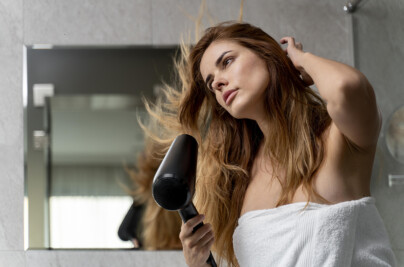Transformative Hair Color and Hair Health
When it comes to hair color transformation, it’s not just about aesthetics; it’s about making informed choices that promote the health and vitality of your hair. At kmhairlounge.com, we believe that every individual should feel confident in their hair, which starts with understanding the journey of color change and how to maintain hair health throughout the process. In this blog post, we will delve into the intricacies of hair color transformation, discuss the importance of hair health, and provide tips for ensuring your hair remains vibrant and strong.

The Psychology of Hair Color Transformation
Changing your hair color is not merely about refreshing your look; it’s often tied to psychological benefits. A new hair color can significantly boost self-esteem and can be a powerful means of personal expression. Whether you’re looking for a subtle change or a bold statement, understanding the implications of color transformation can help you make choices that align with your personality and lifestyle.
Warm tones, for example, can evoke feelings of warmth and comfort, while cooler tones may impart an aura of calm and sophistication. Additionally, a dramatic color change can symbolize personal growth or a new chapter in one’s life, making it a significant milestone.
Choosing the Right Hair Color
Selecting the perfect hair color involves more than just picking a shade you like. It’s essential to consider various factors including your skin tone, eye color, and overall style.
1. Skin Tone Analysis
Understanding your skin tone is crucial for choosing a hair color that complements your features:
Cool Undertones: If you have pink or blue undertones, colors like ash blonde, platinum, or cool browns can be very flattering.
Warm Undertones: Those with golden or peachy undertones generally shine with warm shades like honey blonde, copper, or rich chocolate.
Neutral Undertones: If you have a mix of both cool and warm undertones, feel free to play with a variety of shades.
2. Consider Eye Color
Your natural eye color can also guide your decision. For example, blue or green eyes can pop with shades of blonde or caramel, while brown or hazel eyes can be beautifully highlighted with rich, deep colors.
3. Personal Style
Ultimately, the best color is one that aligns with your personal style. If you love to be adventurous, bold colors like vibrant reds or pastels might suit you. For a more classic look, consider deep, rich shades or soft balayage techniques.
The Process of Hair Color Transformation
Once you’ve settled on a color, it’s time to begin the transformation. Here’s what to expect during the coloring process:
1. Consultation
Before any color application, a thorough consultation with your hair stylist is vital. Discuss your desired look, ask questions, and address any concerns about the color or potential damage. A professional stylist will also advise you on the upkeep and suitability of the color for your hair type.
2. Color Application Techniques
There are several techniques for applying hair color, including:
All-over Color: A single hue applied from roots to tips, ideal for bold transformations.
Balayage: This technique allows for a gradient look, creating lighter ends and a more natural effect.
Ombre: A variation of balayage, where the color shifts from darker roots to significantly lighter ends.
Each technique has its benefits, and your stylist can help you choose the right one based on the desired effect and your current hair condition.
Maintaining Hair Health Post-Transformation
Post-coloring care is key to preserving both the vibrancy of your new shade and the health of your hair. Here are some essential tips:
1. Hydration is Key
Color-treated hair can become dry and brittle. Use a hydrating shampoo and conditioner specifically formulated for color-treated hair. Look for products free of sulfates, as these can strip color.
2. Deep Conditioning Treatments
Incorporate deep conditioning into your routine weekly. Hair masks can help restore moisture and repair damage, leaving your hair softer and shinier.
3. Limit Heat Styling
Frequent use of heat styling tools can cause additional damage. Whenever possible, let your hair air dry and opt for heatless styling methods. When you do use heat, always apply a heat protectant spray beforehand.
4. Regular Trims
Cut off split ends and keep your hair looking its best with regular trims. A good rule of thumb is to schedule a trim every 6-8 weeks, which helps prevent damage from traveling up the strands.
5. Protect from Sun and Chlorine
UV rays and chlorine can fade hair color quickly. If you’re spending time in the sun or swimming, consider wearing a hat or using UV protection hair products. After swimming, rinse your hair immediately to remove chlorine or saltwater.
6. Healthy Diet
A well-balanced diet rich in vitamins and minerals can promote hair health from the inside out. Include foods high in omega-3 fatty acids, proteins, and vitamins A, C, and E to support hair growth and strength.
Consult Professionals for the Best Results
At kmhairlounge.com, we emphasize the importance of professional expertise in achieving the best hair color transformation while keeping your hair healthy. Our experienced stylists are dedicated to providing personalized consultations and high-quality services that cater to your unique needs and preferences. Remember, hair coloring is an art form, and trusting a professional can make all the difference in achieving your dream look.
Conclusion
Transforming your hair color is an exciting journey that allows for self-expression and can rejuvenate your appearance. However, it’s imperative to approach this beautiful transformation with knowledge and care, ensuring that hair health is prioritized alongside aesthetic changes. By understanding color selection, engaging in open consultations, and practicing diligent aftercare, you can achieve vibrant, healthy hair that turns heads. Visit kmhairlounge.com to begin your journey towards the perfect hair color transformation today!
Your hair is your crown; wear it with confidence!




